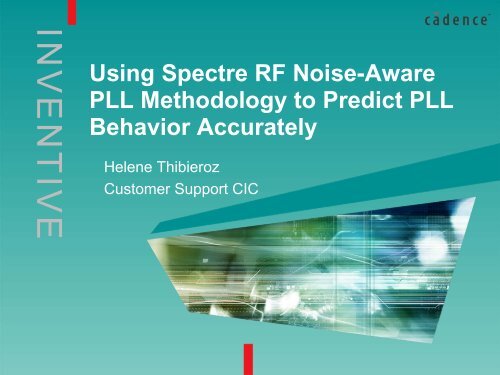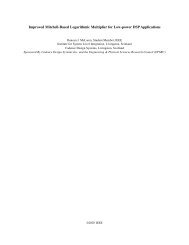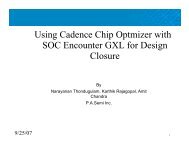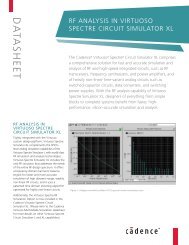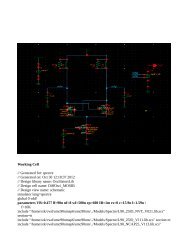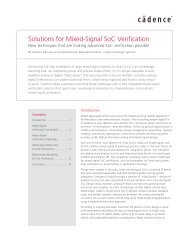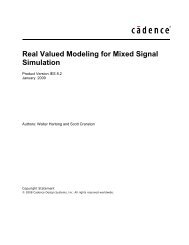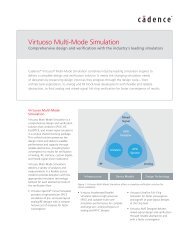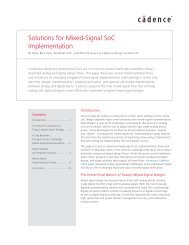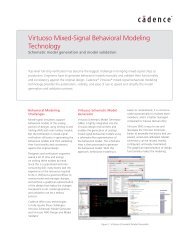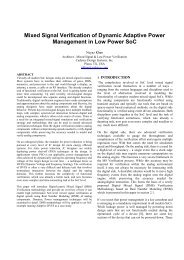Accurate PLL Characterization Using Virtuoso Spectre RF Noise ...
Accurate PLL Characterization Using Virtuoso Spectre RF Noise ...
Accurate PLL Characterization Using Virtuoso Spectre RF Noise ...
You also want an ePaper? Increase the reach of your titles
YUMPU automatically turns print PDFs into web optimized ePapers that Google loves.
INVENTIVE<br />
<strong>Using</strong> <strong>Spectre</strong> <strong>RF</strong> <strong>Noise</strong>-Aware<br />
<strong>PLL</strong> Methodology to Predict <strong>PLL</strong><br />
Behavior <strong>Accurate</strong>ly<br />
Helene Thibieroz<br />
Customer Support CIC
2<br />
<strong>Using</strong> <strong>Spectre</strong> <strong>RF</strong> <strong>Noise</strong>-Aware <strong>PLL</strong> Methodology to<br />
Predict <strong>PLL</strong> Behavior <strong>Accurate</strong>ly<br />
•<br />
•<br />
•<br />
•<br />
•<br />
Introduction<br />
<strong>Spectre</strong> <strong>RF</strong> <strong>Noise</strong>-Aware <strong>PLL</strong> Flow<br />
and Non-Linear VCO Modeling<br />
Advantages of this flow versus<br />
other commercial approaches<br />
Experimental results<br />
Conclusion<br />
September 17, 2007
3<br />
•<br />
•<br />
•<br />
Introduction<br />
Phase locked loops are essential blocks in most analog mixedsignal<br />
and radio frequency (<strong>RF</strong>) applications today.<br />
Because of the complexity of <strong>PLL</strong>s, the different time constants<br />
involved (two widely-spaced time constants), and the fact that the<br />
voltage-controlled oscillator (VCO) frequency often oscillates<br />
several order of magnitude faster than the reference frequency,<br />
simulating <strong>PLL</strong>s at a transistor level presents multiple challenges<br />
and is extremely time demanding.<br />
Cadence <strong>Spectre</strong><strong>RF</strong> <strong>Noise</strong>-aware <strong>PLL</strong> flow enables designers to<br />
efficiently and accurately predict <strong>PLL</strong> response using a non-linear<br />
model approach to capture the VCO dynamic behavior<br />
September 17, 2007
4<br />
Challenges of <strong>PLL</strong> Simulation<br />
•<br />
f ref<br />
<strong>PLL</strong> are “stiff”<br />
–<br />
–<br />
Ref<br />
Div<br />
September 17, 2007<br />
f ref<br />
PFD CP LPF VCO<br />
circuits<br />
Divide by N<br />
Contain two widely-spaced time constants<br />
N * fref<br />
For wireless systems, the VCO often oscillates orders of<br />
magnitude faster than the reference frequency<br />
Out
5<br />
Challenges of <strong>PLL</strong> Simulation<br />
•<br />
•<br />
f ref<br />
Ref<br />
Div<br />
Behavioral model based simulation approaches accelerate<br />
simulation speed, allowing designers to trade-off block<br />
characteristics and <strong>PLL</strong> performance.<br />
Cadence has developed a new non-linear model that allows<br />
designers to accurately simulate the dynamic behavior of the VCO,<br />
such as injection locking and power-supply interference.<br />
September 17, 2007<br />
f ref<br />
PFD CP LPF VCO<br />
Divide by N<br />
N * fref<br />
Out
6<br />
<strong>Using</strong> <strong>Spectre</strong> <strong>RF</strong> <strong>Noise</strong>-Aware <strong>PLL</strong> Methodology to<br />
Predict <strong>PLL</strong> Behavior <strong>Accurate</strong>ly<br />
Introduction<br />
<strong>Spectre</strong> <strong>RF</strong> <strong>Noise</strong>-Aware <strong>PLL</strong> Flow<br />
and Non-Linear VCO Modeling<br />
Advantages of this flow versus other<br />
commercial approaches<br />
Experimental results<br />
Conclusion<br />
September 17, 2007
7<br />
V R<br />
<strong>Spectre</strong> <strong>RF</strong> <strong>Noise</strong>-Aware <strong>PLL</strong> Simulation<br />
ADE Test Bench<br />
and Analysis<br />
PFD CP VCO<br />
V F<br />
Verilog-A –<br />
September 17, 2007<br />
÷<br />
N<br />
Compute<br />
PSS-P<strong>Noise</strong><br />
Transient Analysis<br />
Automatically<br />
generate model<br />
50 μV/√Hz<br />
20 μV/√Hz<br />
10 μV/√Hz 5 μ V/√ Hz<br />
2 μ V/ √ Hz<br />
1 μ V/√ Hz<br />
500 nV/√ Hz<br />
200 nV/√ Hz<br />
100 nV/√ Hz<br />
•<br />
•<br />
•<br />
•<br />
Automated flow for closed<br />
loop <strong>PLL</strong> noise analysis<br />
ADE test bench and<br />
analysis for all <strong>PLL</strong> blocks<br />
Automatic generation of<br />
behavioral models<br />
<strong>Spectre</strong> <strong>RF</strong> enhanced direct<br />
integration<br />
Closed Loop <strong>PLL</strong> <strong>Noise</strong><br />
1 kHz 10 kHz 100 kHz 1 MHz 10 MHz 100 MHz
8<br />
<strong>Spectre</strong> <strong>RF</strong> <strong>Noise</strong>-Aware <strong>PLL</strong> Simulation Flow<br />
1.<br />
2.<br />
3.<br />
4.<br />
In <strong>Spectre</strong><strong>RF</strong>, a <strong>PLL</strong> circuit is partioned as a PFD block and a VCO<br />
block since they have different work frequencies (Other blocks<br />
such as CP, LPF and DIVIDER are being merged in those two<br />
blocks).<br />
<strong>Spectre</strong><strong>RF</strong> solves the two test benches at different frequencies with<br />
PSS (using either time domain and harmonic balance solvers) and<br />
get the large signal operation points.<br />
The Perturbation Projection Vector (PPV) is extracted in the VCO<br />
test bench. Then a <strong>PLL</strong> test bench combines the PFD and VCO<br />
macro models.<br />
<strong>PLL</strong> behavior is then simulated with a TRAN analysis. Since PPV is<br />
used to provide the phase changes, the output of VCO/DIVIDER is<br />
tracing the reference frequency. Also noise information<br />
(represented by Jitter) could be added and simulated with the same<br />
test bench.<br />
September 17, 2007
9<br />
<strong>PLL</strong> Model Extraction Flow<br />
•<br />
•<br />
•<br />
•<br />
September 17, 2007<br />
Place the block to be tested into the testbench<br />
schematic<br />
Invoke ADE, setup simulation and enable model<br />
extraction<br />
Run PSS and PNOISE analysis<br />
– PSS calculates the PPV of the VCO and the<br />
transfer function of the other blocks<br />
– PNOISE calculates the noise characteristics<br />
of the block<br />
<strong>Spectre</strong> automatically generates the model<br />
– Model is generated in two formats: CMI and<br />
Verilog-A models<br />
Place DUT<br />
in Testbench<br />
Start ADE and<br />
Setup Test<br />
Simulate<br />
PSS/PNOISE<br />
Automatically<br />
Generate Model
10<br />
<strong>PLL</strong> Simulation Flow<br />
•<br />
•<br />
•<br />
September 17, 2007<br />
Create new <strong>PLL</strong> Testbench by placing the<br />
extracted models in a <strong>PLL</strong> testbench<br />
Start ADE and setup test simulation<br />
Run Transient Analysis<br />
– Designers have an option to simulate<br />
either with or without noise<br />
– Simulate without noise for <strong>PLL</strong> large signal<br />
characteristics such as lock Time<br />
– Simulate with noise for phase noise and<br />
jitter<br />
Create <strong>PLL</strong><br />
Testbench<br />
Start ADE and<br />
Setup Test<br />
Simulate<br />
Transient<br />
Analyze<br />
Results
11<br />
September 17, 2007<br />
<strong>PLL</strong> testbench using the PPV model<br />
Cell: pll_bench<br />
(custom veriloga) (PPV model)<br />
(schematic)<br />
(power supply<br />
noise injection)<br />
(utility for freq output and saving<br />
periods.txt for phase noise/jitter<br />
calculation)<br />
(LC tank<br />
noise injection)
12<br />
Model Overview<br />
•<br />
•<br />
•<br />
•<br />
•<br />
•<br />
<strong>Noise</strong>-Aware <strong>PLL</strong> flow supports extraction and modeling of Voltage<br />
Controlled Oscillator, Phase/Frequency Detector, Charge Pump, Divider<br />
VCO Model supports<br />
– Single-ended VCO outputs.<br />
– Sensitivity to Tuning Voltage, Positive Power Supply, and Negative<br />
Power Supply.<br />
Phase/Frequency Detector and Charge Pump<br />
– P/FD and CP are merged. .<br />
Divider model<br />
– Divider noise is not extracted.<br />
– The divider is merged into the VCO for faster simulation.<br />
Models are single-ended, voltage output levels<br />
Two types of models are generated<br />
– CMI model will not be editable.<br />
– Verilog-A model will be editable and designers will be able to extend the<br />
model themselves.<br />
September 17, 2007
13<br />
Non-Linear VCO Modeling<br />
•<br />
•<br />
Why do we need nonlinear oscillator models?<br />
–<br />
–<br />
September 17, 2007<br />
Oscillators are fundamentally nonlinear systems.<br />
Linear oscillator models often fail to accurately predict oscillation<br />
amplitude and phase deviations under perturbations [1].<br />
Nonlinear oscillator models can capture the nonlinear dynamics of<br />
oscillators such as injection locking, power supply interference,<br />
cycle slipping, …
14<br />
•<br />
•<br />
•<br />
Non-Linear VCO Modeling<br />
Two main approaches are available and provide the same<br />
information:<br />
–<br />
–<br />
September 17, 2007<br />
Impulse Sensitivity Function ISF ([1], [2], [3]).<br />
Perturbation Projection Vector PPV ([1], [4]).<br />
The two models are tightly related by further observing the<br />
definitions of ISF and PPV. ISF defines the phase sensitivity to state<br />
variables. PPV represents the time sensitivity to the state variables<br />
([1], [6]).<br />
PPV is a more mathematical and precise method of describing the<br />
VCO and is valid for all classes of oscillators contrarily to ISF ([5]).
15<br />
Effect of <strong>Noise</strong> and Perturbation on an<br />
Oscillator<br />
September 17, 2007<br />
Phase<br />
Deviation<br />
New State<br />
x (t)<br />
Orbital<br />
Deviation<br />
Steady-State<br />
xs(t)
16<br />
Non-linear VCO PPV Model<br />
•<br />
•<br />
α(t) is the phase deviation due to perturbation of the VCO and<br />
satisfies the nonlinear differential equation.<br />
Owing to the PPV, νT 1(t),<br />
oscillator phase deviations due to<br />
perturbations can be efficiently evaluated by solving the one–<br />
dimensional nonlinear differential equation (1).<br />
The PPV relates the changes in the circuit’s nodes voltages or<br />
currents to the VCO phase.<br />
September 17, 2007<br />
•<br />
α<br />
() t v n()<br />
t<br />
T<br />
= ∗<br />
1<br />
(10)
17<br />
<strong>Spectre</strong><strong>RF</strong>’s PPV-based VCO Model<br />
•<br />
•<br />
<strong>Spectre</strong><strong>RF</strong>’s PSS analysis calculates and outputs the PPV for an<br />
oscillator in a file stored in the simulation results directory.<br />
<strong>Spectre</strong><strong>RF</strong> uses the information about a VCO’s PPV to implement a<br />
trajectory-piecewise PPV model for the VCO.<br />
September 17, 2007<br />
[6]
18<br />
<strong>Using</strong> <strong>Spectre</strong> <strong>RF</strong> <strong>Noise</strong>-Aware <strong>PLL</strong> Methodology to<br />
Predict <strong>PLL</strong> Behavior <strong>Accurate</strong>ly<br />
Introduction<br />
<strong>Spectre</strong> <strong>RF</strong> <strong>Noise</strong>-Aware <strong>PLL</strong> Flow<br />
and Non-Linear VCO Modeling<br />
Advantages of <strong>Spectre</strong><strong>RF</strong> flow<br />
versus other approaches<br />
Experimental results<br />
Conclusion<br />
September 17, 2007
19<br />
•<br />
•<br />
•<br />
Strengths of <strong>Spectre</strong><strong>RF</strong> <strong>Noise</strong> aware <strong>PLL</strong> flow<br />
Significantly decreases simulation time compared to a<br />
traditional spice/fast spice transient approach:<br />
–<br />
–<br />
Even simple <strong>PLL</strong>s can require 2-3weeks when simulating with<br />
traditional SPICE simulators.<br />
Complex <strong>PLL</strong>s can easily require 2-3 months.<br />
Provides accuracy comparable to a traditional spice<br />
transient approach:<br />
–<br />
The VCO dynamic behavior is fully captured by using a non<br />
linear model based on PPV.<br />
Supports both Integer-N and Fractional <strong>PLL</strong>s<br />
September 17, 2007
20<br />
•<br />
•<br />
•<br />
•<br />
Strengths of <strong>Spectre</strong><strong>RF</strong> <strong>Noise</strong> aware <strong>PLL</strong> flow<br />
Calibrates the VCO and PFD/CP model automatically<br />
–<br />
September 17, 2007<br />
No behavioral modeling expertise required<br />
– Models automatically generated during <strong>Spectre</strong><strong>RF</strong> noise<br />
simulations<br />
Provides an option to simulate either with or without noise: Simulate<br />
without noise for <strong>PLL</strong> large signal characteristics (Lock Time) or with<br />
noise for phase noise, jitter or injection pulling metrics.<br />
Provides an option to look at <strong>PLL</strong> advanced metrics such as<br />
injection pulling or power supply noise rejection through ADE direct<br />
plot form.<br />
Benefits from a tight <strong>Spectre</strong><strong>RF</strong> integration using our Simulator<br />
Kernel Interface (SKI) allowing better simulation performances.
21<br />
<strong>Using</strong> <strong>Spectre</strong> <strong>RF</strong> <strong>Noise</strong>-Aware <strong>PLL</strong> Methodology to<br />
Predict <strong>PLL</strong> Behavior <strong>Accurate</strong>ly<br />
Introduction<br />
<strong>Spectre</strong> <strong>RF</strong> <strong>Noise</strong>-Aware <strong>PLL</strong> Flow<br />
and Non-Linear VCO Modeling<br />
Advantages of this flow versus other<br />
commercial approaches<br />
Experimental results<br />
Conclusion<br />
September 17, 2007
22<br />
•<br />
•<br />
•<br />
•<br />
Experimental Results using Cadence <strong>RF</strong>kit database<br />
The test circuit used was a N-Integer 2.4 GHz <strong>PLL</strong> including a PFD,<br />
charge pump, VCO and divider available in Cadence <strong>RF</strong>Kit ([8], [9]).<br />
<strong>Using</strong> Cadence <strong>Spectre</strong><strong>RF</strong> <strong>PLL</strong> flow (versions IC5141/MMSIM611),<br />
the phase noise was extracted for the PFD and VCO blocks to<br />
generate a phase-domain model for the entire <strong>PLL</strong>.<br />
The closed-loop <strong>PLL</strong> behavior is then simulated using <strong>Spectre</strong><br />
TRAN analysis and compared with transistor level simulation.<br />
–<br />
September 17, 2007<br />
Results generated on an IBM MPRO Linux 64 bits OS.<br />
Additional metrics (Injection Pulling, power supply rejection) are<br />
directly evaluated
23<br />
September 17, 2007<br />
PPV versus transistor-level Settling time<br />
Simulation<br />
results<br />
<strong>Spectre</strong><br />
Transistor level<br />
simulation<br />
PPV Sampling*=1 46 hours<br />
Experimental data extracted from <strong>PLL</strong> test circuit<br />
available in Cadence <strong>RF</strong> kit ([8] and [9])<br />
<strong>Spectre</strong><br />
PPV CMI/VerilogA<br />
simulation<br />
Simulation<br />
Ratio<br />
10.8 s 15285<br />
(165.08Ks)<br />
PPV Sampling*=50 8 min 35s (515s) 320<br />
*Sampling refers to the number of sample points per period. To calculate the phase accurately, the transient time step is<br />
bounded as ((1/(vco frequency)) / sample points per period
24<br />
<strong>PLL</strong> <strong>Noise</strong>-Aware Flow Experimental results<br />
Impact on Injection Pulling and Power <strong>Noise</strong> supply on a N-<br />
Integer <strong>PLL</strong> performance [10]<br />
Impact of Power Supply <strong>Noise</strong><br />
rejection on <strong>PLL</strong> phase noise:<br />
No “beat” freq generated (injection<br />
noise at 10M generates spur at 10M)<br />
September 17, 2007<br />
Impact of Injection noise pulling on<br />
phase noise:<br />
Spurs in phase noise spectrum
25<br />
<strong>PLL</strong> <strong>Noise</strong>-Aware Flow Experimental results<br />
Same measurements were performed on a fractional <strong>PLL</strong> [10].<br />
Phase <strong>Noise</strong> was obtained using ADE Direct Plot form<br />
Impact of Injection noise pulling:<br />
Spurs in phase noise spectrum are<br />
present after noise injection<br />
September 17, 2007
26<br />
<strong>Using</strong> <strong>Spectre</strong> <strong>RF</strong> <strong>Noise</strong>-Aware <strong>PLL</strong> Methodology to<br />
Predict <strong>PLL</strong> Behavior <strong>Accurate</strong>ly<br />
Introduction<br />
<strong>Spectre</strong> <strong>RF</strong> <strong>Noise</strong>-Aware <strong>PLL</strong> Flow<br />
and Non-Linear VCO Modeling<br />
Advantages of this flow versus other<br />
commercial approaches<br />
Experimental results<br />
Conclusion<br />
September 17, 2007
27<br />
Conclusions<br />
•<br />
•<br />
•<br />
•<br />
Cadence <strong>Spectre</strong><strong>RF</strong> <strong>Noise</strong>-aware <strong>PLL</strong> flow predicts the phase noise<br />
of a <strong>PLL</strong>-based frequency synthesizer using a simulation method<br />
that is both accurate and efficient.<br />
For each block, the phase noise is extracted and applied to a<br />
phase-domain model for the entire <strong>PLL</strong>.VCO phase noise is<br />
accurately characterized using advanced perturbation technology<br />
(PPV).<br />
Strengths of this flow (automatic calibration, greatly improved<br />
simulation time without loss of accuracy, direct plotting capability of<br />
<strong>PLL</strong> metrics) were presented.<br />
Compared to traditional approaches, experimental data confirmed a<br />
significant speed-up with comparable accuracy.<br />
September 17, 2007
28<br />
References<br />
•<br />
•<br />
•<br />
•<br />
•<br />
[1] Emad Hegazi, Jacob Rael, Asad Abidi. The Designer’s Guide to<br />
High-Purity Oscillators. Kluwer Academic Publishers, 2005<br />
[2] Hajimiri A, Lee T H. A General Theory of Phase <strong>Noise</strong> in<br />
Electrical Oscillators. IEEE Journal of Solid-State Circuits, 1998,<br />
33(2): 179~194<br />
[3] Lee T H, Hajimiri A. Oscillator Phase <strong>Noise</strong>: A Tutorial. IEEE<br />
Journal of Solid-State Circuits,2002, 35(3): 326~336<br />
[4] Demir A, Liu E W Y, and Sangiovanni-Vincentelli A L. Timedomain<br />
non Monte-Carlo noise simulation for nonlinear dynamic<br />
circuits with arbitrary excitations. IEEE Transactions for Computer-<br />
Aided Design, 1996, 15(5): 493~505<br />
[5] Vanassche P, Gielen G and Sensen W. On the Difference<br />
between Two Widely Publized Methods for Analyzing Oscillator<br />
Phase <strong>Noise</strong> Behavior. Proceeding IEEE/ACM ICCAD 2002<br />
September 17, 2007
29<br />
References<br />
•<br />
•<br />
•<br />
•<br />
•<br />
[6] Automated oscillator macromodelling techniques for capturing<br />
amplitude variations and injection locking “, X. Lai, J.<br />
Roychowdhury , ICCAD, 2004, 687-694<br />
[7] “TP-PPV: Piecewise Nonlinear, Time-Shifted Oscillator<br />
Macromodel Extraction For Fast, <strong>Accurate</strong> <strong>PLL</strong> Simulation“, X. Lai,<br />
J. Roychowdhury , ICCAD, 2006<br />
[8] Cadence <strong>RF</strong> kit user guide version 5.2.1, February 2007<br />
[9] Cadence <strong>RF</strong>IC design methodology kit workshop, version 5.2.1,<br />
February 2007<br />
[10] <strong>Spectre</strong><strong>RF</strong> Workshop <strong>Noise</strong>-Aware <strong>PLL</strong> Design Flow,<br />
MMSIM6.2, August 2007<br />
September 17, 2007
30<br />
September 17, 2007


